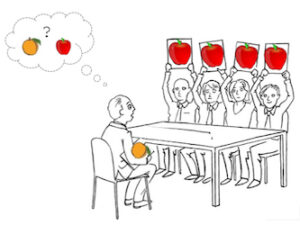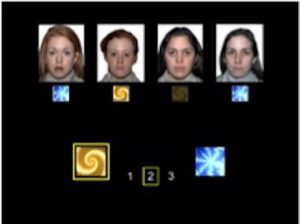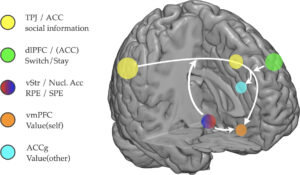Social Influence in Human Decision-Making
 When we go about our daily lives, we constantly observe the behavior of others and obtain social information from them. How do we integrate this information into our own decisions? Do we always adhere to the group decision or do we rely on the group decision only, when we are uncertain about the best option?
When we go about our daily lives, we constantly observe the behavior of others and obtain social information from them. How do we integrate this information into our own decisions? Do we always adhere to the group decision or do we rely on the group decision only, when we are uncertain about the best option?
 To answer this question about the neural correlates of observational social learning, Lei Zhang devised a new social influence task (Zhang & Gläscher, 2020): participants have to choose between two options, whose value changes several times through the experiment ( a reversal learning task). They also see the choices of 4 other actual participants (not fake computer simulations), before they can revise their first choice. Finally, a probabilistic outcome is presented to all participants. Having the same decision twice before and after the social information is probably the most direct way to measure social influence.
To answer this question about the neural correlates of observational social learning, Lei Zhang devised a new social influence task (Zhang & Gläscher, 2020): participants have to choose between two options, whose value changes several times through the experiment ( a reversal learning task). They also see the choices of 4 other actual participants (not fake computer simulations), before they can revise their first choice. Finally, a probabilistic outcome is presented to all participants. Having the same decision twice before and after the social information is probably the most direct way to measure social influence.

We observed a strong interaction effect between group consensus and decision type of the group: the more the group differed from my own first choice, the more I am willing to adapt the group’s predominant choice. We developed a reinforcement learning model for this task that discriminates between the own valuation process and that of the group. This modeling effort reveals that my own that others’ values contribute equally to the first decision, whereas the decision to switch or stay is determined by both the group consensus and the difficulty of the first decision. In essence, our own final decision is a careful negotiation process between our own experience and the social information obtained from others.
 In model-based analyses of the fMRI data, we were able to delineate a network of brain regions involving the core decision-making network (e,g, ventral striatum, vmPFC) as well as a social network (e.g. temporo-parietal junction (TPJ)) involved in representing social information. The nodes in these networks represented distinct computations derived from the cognitive model of the task.
In model-based analyses of the fMRI data, we were able to delineate a network of brain regions involving the core decision-making network (e,g, ventral striatum, vmPFC) as well as a social network (e.g. temporo-parietal junction (TPJ)) involved in representing social information. The nodes in these networks represented distinct computations derived from the cognitive model of the task.
In a follow-up study, we used TMS over bilateral TPJ to investigate the causal contribution of this brian region to the integration of social information into human decision-making. We indeed observed a modulation of the interaction effect: after stimulating the left TPJ, participants were less likely to switch their decision when confronted with divergent group decisions.
We are now working on a strategic (competitive) version of the social influence task, in which participants compete with their choices for limited rewards and can deceive their co-players. In this version value integration is additionally influenced by social motives like trust and reputation management, as deception reduces trust of the others and hence diminishes the influence that I can exert on the choices of others.